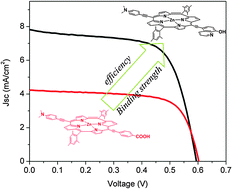8-Hydroxylquinoline-conjugated porphyrins as broadband light absorbers for dye-sensitized solar cells
Abstract
Three porphyrin dyes, DPZn-HOQ, PZn-HOQ and DPZn-COOH, were synthesized and characterized for dye-sensitized solar cells. Both DPZn-HOQ and DPZn-COOH exhibited a donor–π–acceptor configuration with N,N-dimethylaniline as a donor and 8-hydroxylquinoline (HOQ) and para-benzoic acid (BZA) as acceptors, respectively. PZn-HOQ is an analogue of DPZn-HOQ without a donor. It was found that DPZn-HOQ exhibited broader and stronger light absorption capability in the red region than DPZn-COOH. Theoretical calculations showed that the electrons were delocalized to the 8-hydroxylquinoline ring in DPZN-HOQ. The DPZn-HOQ-sensitized solar cells exhibited higher energy conversion efficiency (3.09%) than DPZn-COOH-sensitized solar cells (1.76%) under the same conditions. The results were consistent with the incident photon to current conversion efficiency (IPCE) spectra. The electrochemical impedance spectroscopy studies revealed that HOQ-conjugated porphyrin exhibited high electron recombination resistance and a long electron lifetime, which was attributed to the effective shielding of DPZn-HOQ from the electrolyte due to its tilted orientation on the surface of TiO2 nanoparticles. The efficiency of DPZn-HOQ-sensitized solar cells was further increased to 3.41% when a complementary dye BET was used.


 Please wait while we load your content...
Please wait while we load your content...